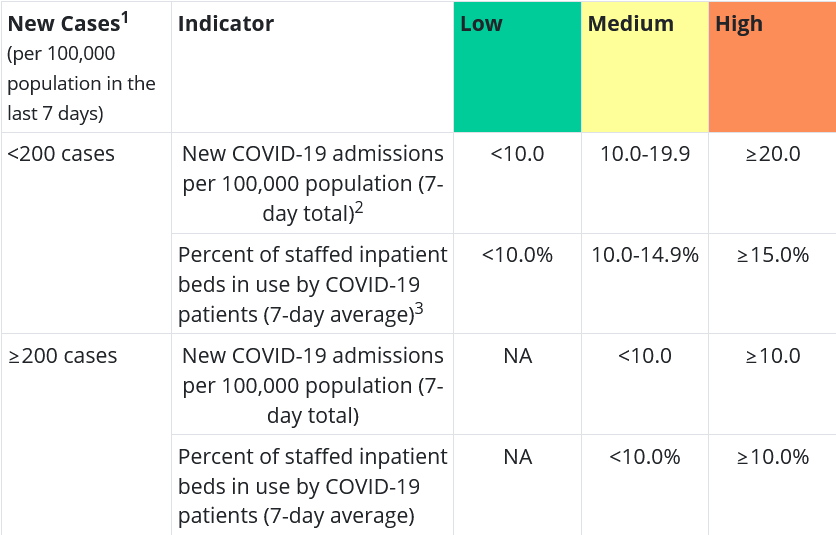With the COVID-19 “pandemic” dragging on…and on….and on….one has to wonder exactly what is there in the data that justifies calling the situation an “emergency”.
Politics aside, is there anything about the current state of COVID-19 infections and hospitalizations in this country that warrants the especial considerations imputed by the term “emergency”? The data does not exactly lend clear and unequivocal support to the HHS’ current insistence that COVID-19 is an “emergency”.
The “High” Community Level In The CDC Rating System
To understand the CDC’s data, a brief summation of the CDC Community Levels system is in order.
The Community Levels system is an effort by the CDC to provide a quick communication on a county’s status with respect to COVID-19 infections and their putative public health impact as measured by hospitalizations. There is some notional logic to this concept, as a county with a higher percentage of patients in hospital due to COVID-19 is expending a greater share of public health resources on COVID-19 patients than a county with a lower percentage of such patients.
These measurements are used to define a ratings system of “Low”, “Medium”, and “High” levels of COVID-19 infection, as follows:
However, there is an important caveat: The CDC updates a county’s level only once per week, on Thursday, even though it updates case, death, and hospitalization data daily (no doubt there is some bureaucrat somewhere within the bowels of the CDC to whom this makes perfect sense).
Thus, it is possible for the community level rating for a county to be out of sync with the realtime data, which diminishes the accuracy and thus the utility of the ratings system.
Is Los Angeles An “Emergency”?
The CDC rates Los Angeles County’s COVID-19 Community Level as “High”—time for Los Angelenos to mask up, social distance, and (of course) get yet another inoculation shot which does nothing against COVID-19 but does inflict a lovely bevy of adverse and often lethal side effects1.
However, the CDC also says that the case rate has declined by 17% over the past week2.
Test positivity rates are declining even as tests performed are declining.
Yet despite what the media propaganda has to say about COVID-19 in the City of Angels, hospitalizations are also declining. COVID-19 patients have been a small minority of hospital patients for quite some time.
In reality, based on the hospitalization rates as of August 7th, Los Angeles County is not in “High” COVID status but is only at a “Medium” status. Is that an “emergency”?
Is Chicago An “Emergency”?
Chicago (Cook County, Illinois) is another locale rated as “High” by the CDC. Yet, according to the CDC, the test positivity rates are falling there as well.
Ironically, Cook County in “High” status has a lower percentage of hospital resources being consumed by COVID-19 patients than Los Angeles County, which is properly classed as “Medium” status.
Are Cook County’s hospitalizations the stuff of a public health “emergency”, even at a CDC Community Level of “High”?
Is San Antonio An “Emergency”?
San Antonio (Bexar County, Texas) is another jurisidiction classified as “High” by the CDC. Moreover, it is worth noting that, at 29.17%, the test positivity rate is higher than in Los Angeles or Chicago, and has even inched up in recent days.
Yet even in San Antonio, hospitalization trends are largely declining.
With a lower hospitalization percentage than Los Angeles, declining new admissions and ICU utilization among COVID patients, can San Antonio truly be said to be in a public health “Emergency”?
Hospitalization ARE Key. But Hospitals Are NOT In Crisis
While the pace of hospitalizations are a valid and important measure of the public health burden of disease on a county, it is difficult to see how declining hospitalizations—which in most counties are not rising above 10%—constitute a clear public health crisis. In every county, COVID patients are a small minority of the hospital system’s patient load. That is the clear and unambiguous message of the CDC’s own data.
Even counties which are technically in “High” status based on the CDC’s definitions for the various community levels cannot be truly said to be in crisis as a result of COVID patients being in hospital.
COVID-19 is a real disease, and for those with preexisting health problems and co-morbidities, COVID-19 can be a real concern. It is not a disease that should be simply ignored by anyone—infectious respiratory diseases can and do kill, and deserve to be taken seriously.
However, taking a disease seriously means taking prudent precautions based on one’s own health and personal risk assessments. Taking a disease seriously means practicing good hand hygiene, and taking care to socially distance from individuals displaying symptoms (don’t go near the person hacking up a lung). Taking a disease seriously does not require jeopardizing one’s health with a dangerous experimental mRNA inoculation whose recorded adverse events are many orders of magnitude greater than all other vaccine preparations put together3.
COVID-19 is a genuine health concern. It is not a public health crisis, however, and it arguably is not a public health emergency anywhere in the United States.
The red flags from the mRNA inoculations is a topic that I have discussed at length in this Substack. New readers are invited (and encouraged) to read more on this topic, and also to look at the excellent deep dives on inoculation data provided by Igor Chudov.
CDC statistics for each county are as of August 7, 2022, and the data gathered on 8 August 2022. The data is subject to change on a daily basis.
1,371,471 reports of adverse events from COVID-19 inoculations submitted to the VAERS database through July 29, 2022.












CDC is modeling and caps now @ 95% their numbers are simply fraud!
I’ve been crying about the Emergency put in place for awhile now. It is only put there for an agenda served up as an Executive Order. That’s my take.